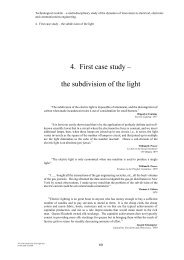Valuation Techniques for Social Cost-Benefit Analysis: - HM Treasury
Valuation Techniques for Social Cost-Benefit Analysis: - HM Treasury
Valuation Techniques for Social Cost-Benefit Analysis: - HM Treasury
You also want an ePaper? Increase the reach of your titles
YUMPU automatically turns print PDFs into web optimized ePapers that Google loves.
1 Introduction<br />
The Green Book refers to two techniques <strong>for</strong> the valuation of non-market impacts: Stated<br />
Preference and Revealed Preference methods. Stated Preference uses specially constructed<br />
questionnaires to elicit estimates of people‘s Willingness to Pay <strong>for</strong> (or Willingness to Accept) a<br />
particular outcome. Revealed preference observes people‘s behaviour in related markets. These<br />
‗preference-based‘ techniques have been in use <strong>for</strong> some time as an essential part of <strong>Social</strong> <strong>Cost</strong>-<br />
<strong>Benefit</strong> <strong>Analysis</strong>. During this time, the behavioural sciences and other research has built up an<br />
evidence base about the potential uses of these methods, as well as their limitations.<br />
In contrast to these preference-based techniques, a newer, ‗subjective well-being‘ approach, has<br />
been gaining popularity in recent years, which attempts to measure people‘s experiences rather<br />
than expose their preferences. The Life Satisfaction Approach uses reported life satisfaction in<br />
surveys such as the ONS‘s Integrated Household Survey, which began including questions on<br />
respondents‘ subjective well-being in April 2011, to value non-market impacts. The approach<br />
uses econometric methods to estimate the life satisfaction provided by non-market goods, and<br />
this is then converted into a monetary figure by also estimating the effect of income on life<br />
satisfaction. The approach there<strong>for</strong>e assesses the impact of policies on how people think and<br />
feel about their lives as a whole, instead of assessing impact based on what people say they<br />
want and what they choose.<br />
This paper has been written with three main objectives in mind:<br />
First and <strong>for</strong>emost, to demonstrate that the valuation of non-market goods, and<br />
specifically the measurement of well-being, is a live research issue across government<br />
and academia, and one which Departments should be challenged to pursue further.<br />
To provide an introduction to how analysts should go about applying all three<br />
approaches in practice.<br />
To cover the strengths and weaknesses of the three methods in detail to enable analysts<br />
to use the findings generated appropriately and interpret them with the appropriate<br />
degree of caution or enthusiasm in order to provide decision makers with high quality<br />
advice. Specifically in this regard, we recognise that subjective well-being at the<br />
moment remains an evolving methodology, but one which may soon provide a<br />
complement to the more traditional economic approaches. In the meantime, it can play<br />
an important role in challenging analysts and decision makers to think about the full<br />
range of social impacts, and may give us a better idea of the relative value of non market<br />
goods‖.<br />
The rest of the paper proceeds as follows. Chapter 2 presents a brief overview of the economic<br />
theory underlying applied valuation. A concise description of the practical methodology of the<br />
three valuation approaches is laid out in Chapter 3. Chapter 4 contains the bulk of the paper<br />
and presents a comprehensive overview of the strengths and weaknesses of all three<br />
approaches. In particular the Chapter draws on findings from the field of behavioural economics<br />
which have shaped recent discussion on valuation in the economics literature. Chapter 5 builds<br />
on the discussion that precedes it to provide more detail on how to apply the life satisfaction<br />
approach in practice. This Chapter is written in order help Departments pursue the life<br />
satisfaction research agenda further. Chapter 6 discusses some issues that are likely to attract<br />
7





![AIRTO [Professor Dr Brian Blunden] - HM Treasury](https://img.yumpu.com/15492848/1/184x260/airto-professor-dr-brian-blunden-hm-treasury.jpg?quality=85)










